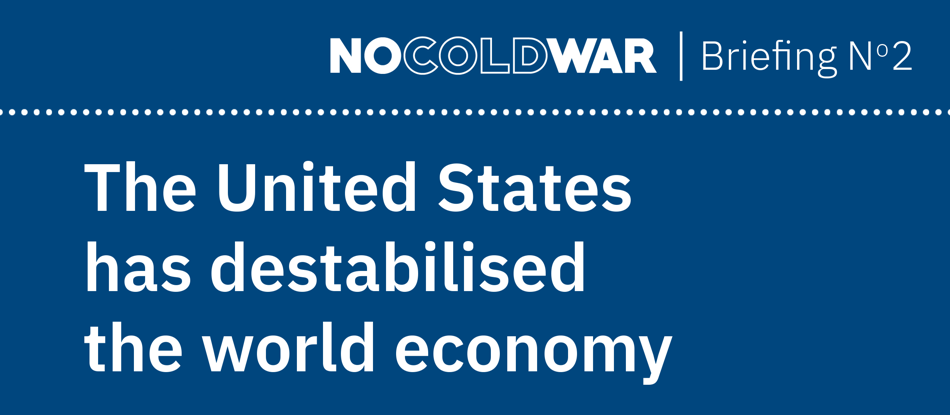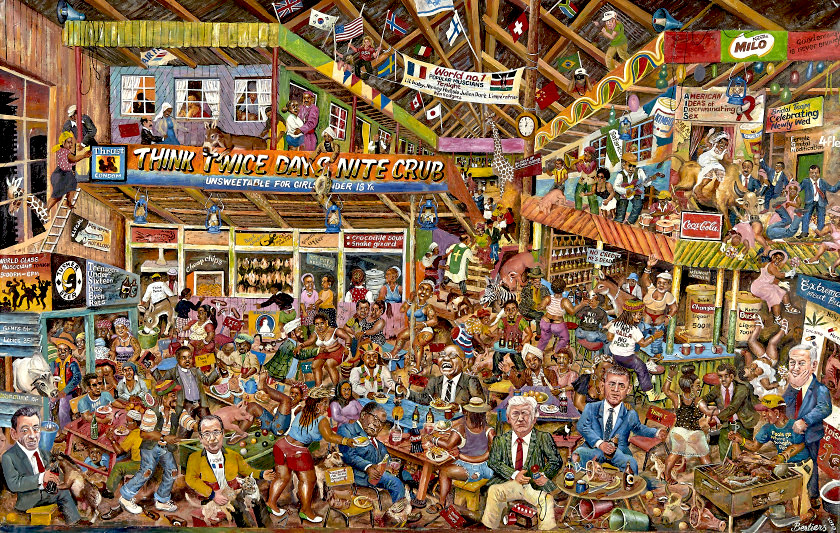For an explanation of the massive inflationary wave that is now cresting on the world and causing widespread suffering and instability, Vijay Prashad turns to U.S. economic policy.

Takashi Murakami, Japan, “Tan Tan Bo Puking – a.k.a. Gero Tan,” 2002.
By Vijay Prashad
Tricontinental: Institute for Social Research
 On April 19, the International Monetary Fund released its annual World Economic Outlook, which forecasted a severe slowdown in global growth along with soaring prices.
On April 19, the International Monetary Fund released its annual World Economic Outlook, which forecasted a severe slowdown in global growth along with soaring prices.
“For 2022, inflation is projected at 5.7 percent in advanced economies and 8.7 percent in emerging market and developing economies – 1.8 and 2.8 percentage points higher than projected in … January.”
IMF Managing Director Kristalina Georgieva offered a sobering reflection on the data:
“Inflation is reaching the highest levels seen in decades. Sharply higher prices for food and fertilizers put pressure on households worldwide – especially for the poorest. And we know that food crises can unleash social unrest.”
What is the root cause of this extraordinary wave of inflation? U.S. President Joe Biden blamed Russia’s war in Ukraine: “What people don’t know is that 70 percent of the increase in inflation was the consequence of [Russian President Vladimir] Putin’s price hike because of the impact of oil prices.”
However, even The Wall Street Journal editorial board noted that “this isn’t Putin’s inflation.”
Georgieva of the IMF has tried to walk a middle ground, saying that “Russia’s invasion of Ukraine has created a crisis on top of a crisis.” Her view mirrored that of the World Economic Outlook, which pointed out that ‘the crisis unfold[ed] while the global economy was on a mending path but had not yet fully recovered from the Covid-19 pandemic.”

Beauford Delaney, U.S., “Exchange Place,” 1943.
The No Cold War platform, with whom Tricontinental: Institute for Social Research has a close working relationship, has produced a very important intervention into this debate. Briefing No. 2, “The United States Has Destabilised the World Economy.”
It makes the case that a governing factor in the current inflation crisis is the outsized impact of the United States on the global economy. U.S. military spending, the scale of the United States in global consumption, the role of the Wall Street-Dollar-IMF regime and other factors play a key role. We hope you find briefing No. 2 useful and circulate it widely.

The International Monetary Fund has announced that the global economy is entering a major slowdown, downgrading the growth prospects of 143 countries.
At the same time, inflation rates have reached historic levels. Around the world, hundreds of millions of people are falling into poverty, particularly in the Global South. Oxfam has sounded the alarm that we are “witnessing the most profound collapse of humanity into extreme poverty and suffering in memory.” What is producing this immense human suffering?
Economic Crisis ‘Made in Washington’
On April 13, U.S. Treasury Secretary Janet Yellen claimed that this global economic deterioration was due to the Russian war in Ukraine. This is factually incorrect. Although the conflict has worsened the situation, the key driver which has destabilized the world economy is the massive inflationary wave that had already built up in the United States and has now begun to crest on the world.
Prior to the war in Ukraine, U.S. inflation had already tripled in recent years from 2.5 percent (January 2020) to 7.5 percent (January 2022) before accelerating further to 8.5 percent (March 2022) after the war broke out.
“This isn’t Putin’s inflation,” the Wall Street Journal editorial board noted. “This inflation was made in Washington.”
The U.S. consumer market absorbs a fifth of the world’s goods and services; as the demand for these goods outstrips the global supply, the tendency for U.S. inflation to spread around the world is very high.
The average Commodity Research Bureau Index, a general indicator of global commodity markets, has risen astronomically: as of April 25, year-to-year prices have soared for oil (60 percent), palm oil (60 percent), coffee (56 percent), wheat (45 percent), natural gas (139 percent) and coal (253 percent). These price increases have sent shock waves through the global economy.
This instability is inseparably connected to U.S. economic policy. Since 2020, the United States has increased its budget by $2.8 trillion. To finance this budgetary expansion, the U.S. government increased borrowing to 27 percent of the gross domestic product (GDP), and the Federal Reserve Bank increased the money supply (the quantity of money issued) by 27 percent year-on-year. Both of these increases are the highest in U.S. peacetime history.
These huge U.S. economic packages were generated to put cash in the hands of consumers. The U.S. government focused on the economy’s demand side by putting money into circulation for consumption, but it did not increase spending on the economy’s supply side by putting money into investment. From 2019–21, 98 percent of U.S. GDP growth was in consumption, while only 2 percent was in net investment. With a large increase in demand by consumers and almost no increase in supply, a huge inflationary wave grew in the United States.

Carmen Lomas Garza, U.S., Tamalada, 1990.
Investing in Guns or People?
Inflation in the United States, which has global implications, is a by-product of its economic priorities. For the past half-century, U.S. governments have not used the country’s social wealth to make substantial social investments in areas such as education, healthcare, and infrastructure, nor have they invested in the manufacturing sector to increase supply.
Instead, to manage inflation the government has chosen to push an agenda which cuts demand. These cuts in demand have already lowered living standards; for instance, real wages in the United States have fallen by 2.7 percent in the past year.
Instead of making social investments to prevent such economic downturns, the U.S. government has prioritized its military, which receives a budget increase every year.
In 2022, the Biden administration proposed a military budget of $813 billion, a 9.2 percent increase over the military budget in 2021. To justify this massive expenditure, the Biden administration, like the Trump administration before it, has invoked the need to “combat threats” posed by China and Russia.
A reduction in U.S. military spending would free up government funds to invest in education, healthcare, infrastructure, and manufacturing. However, this would necessitate a shift in U.S. foreign policy, which does not appear to be on the horizon. Until that time, the people of the United States and other countries will have to sustain the costs of Washington’s new Cold War.

Joseph Bertiers, Kenya, “The Bar,” 2020.
Against the shallow assessment that global inflation is caused by Russia’s war on Ukraine and the Western sanctions on Russia, No Cold War’s briefing No. 2 points its finger at the root of the crisis: the distortions produced by U.S. military spending and by the Wall Street-Dollar-IMF regime gripping the world economy.
In December 2021, the IMF’s Georgieva said that Europe’s governments must not allow economic recovery to be endangered by the “suffocating force of austerity.” This is part of the West’s astonishing double-standards. At the same time, the IMF has enforced harsh austerity measures on the countries of Africa, Asia and Latin America.
As Oxfam notes in a new analysis, during the pandemic’s second year (from March 2021 to March 2022), the IMF approved 23 loans to 22 countries in the Global South — all of which either encouraged or required austerity measures.
For example, the IMF’s $2.3 billion loan agreement with Kenya required a four-year public sector pay freeze alongside higher taxes on gas and food, all while 63 percent of Kenyan households experience multidimensional poverty, according to a report by the Kenya Institute of Public Policy Research and Analysis (KIPPRA).
The austerity policies that impact the vast mass of the populations in these countries must be reversed. We need less money spent on war and more money spent to solve what Frantz Fanon called the obstinate facts of human life, such as hunger, illiteracy and indignity.

Langston Hughes’s poetry focused on the impact of these “obstinate facts” on the lives of people in the United States, people who fought against a life built on wages that equaled “two bits minus two.”
In 1962, the United States spent $49 billion on its military ($431 billion in 2022 dollars); in 2022, as noted in briefing No. 2, the U.S. government proposes to spend $813 billion on its military, larger than the military spending of the next 11 countries combined.
There is immense social wealth available to us, but it is spent on the parts of human life that are most destructive rather than productive. In 1962, as the U.S. military budget began to balloon, Langston Hughes wrote:
I tire so of hearing people say,
Let things take their course.
Tomorrow is another day.
I do not need my freedom when I’m dead.
I cannot live on tomorrow’s bread.
Freedom
Is a strong seed
Planted
In a great need.
I live here, too.
I want my freedom
Just as you.
We need to advance to the goal of human emancipation now. Not tomorrow, but now.
Vijay Prashad, an Indian historian, journalist and commentator, is the executive director of Tricontinental: Institute for Social Research and the chief editor of Left Word Books.
This article is from Tricontinental: Institute for Social Research.
The views expressed are solely those of the author and may or may not reflect those of Consortium News.

This Article fails to take in account the influx of people into the United States and economic impact of such. March alone had 210,000 people come in from Mexico. Adding 2 million a year to a nation will most defiantly impact the financial well being of such, not to mention the stress on commodity’s, support system , resources to house and sustain and care for them. There is no doubt this administration has a broad plan for economic destruction and increased oversight, division and control like none have seen before… it’s not going to end well at this pace…
There is something I don’t understand here:
“These huge U.S. economic packages were generated to put cash in the hands of consumers. The U.S. government focused on the economy’s demand side by putting money into circulation for consumption…”
I am unaware of any such windfall for the working class in the US. I was under the impression the QE and other state subsidy programs were mostly going to the already well-heeled. If that is what drove consumption, is there some variant of horse-and-sparrow theory going on? I must be missing something.
Massive military spending doesn’t help consumers, neither does QE for corporations, but if interest rates have been kept deliberately low so the working class indebted themselves whilst maintaining regular lifestyles, then maybe consumption increases are from the funds which used to go to banks as debt service. I’m still lost.
In the end, in a market system prices rise when the owners decide they can get away with it. It isn’t some sort of law-of-nature. It’s just individuals with a lot taking more from everyone else as opportunity allows (scarcity, fashion, disaster profiteering, etc). That the grifting is partly organized is just class war wearing the clothing of systemic legitimacy.
…but I haven’t had a coffee this morning as yet.
I mean, if the demand-side has been catered for as the founding thesis of the article, where is that seen? What policy did that?
GDP is a broken notion, because it puts the total economy into a graph which is meaningless to most people’s lives.
If the economy is doing well by GDP, that has little relationship to the lives or “PPP”of the majority.
I just see a debt/finance bubble, based on no real productivity, the losses of which are going to be passed to the many, unless the US can find a way to get someone else to generate demand for US dollars, in a world where this demand is diminishing. Rightly so. The US learned nothing from 2008, because even if it did learn something, the state seems less powerful to make policy than the FIRE sector; the primary beneficiaries of QE.
Without a great big war, the US is totally unsustainable. It either has to conquer and annex new markets to keep the growth ponzi scheme going, or it must restructure, including restraining the profit motive of the MIC. Restructuring would require a haircut for those who would rather murder millions overseas than see their own wealth share decline. If the US cannot grow in real terms, it will always get violent to just… not have to change…
This has nothing at all to do with the wishes of the people in the US, those can often be forged (or divided) by crushing media hegemony. This is a capitalism problem, where supporting extremist fighters to destroy the stability of other peoples’ nations is cheaper than… building something more resilient than Hollywood, or predatory usury for others on a global scale.
I’m sure I still don’t get it, but Vijay has often been insightful in the past. My guess is that Michael Hudson has a finger on the pulse of this. But hey, tell me what I’m missing here. I’d love to learn where I screwed up.
I think you have this all down pretty well.
Your comment about Micheal Hudson is 100% and exactly right.
Humans have a response to things that saturate their minds with fear, anxiety, apprehension of the unpleasant and / or unknown. Sometimes this affect can “freeze” one for segment of time. Often referred to the flight, fight or “freeze syndrome. This may be your problem here grasping this new reality.
This is the truth about America, the difference is that everything is out in the open.
Including the bogus activist SCOTUS. 80% of Americans don’t want ROE V WADE overturned. So why are the doing this? To divide the country I think. I hope it does, divide us from them, the dimos and the repugs.
The only explanation for the crazies in DC is #1 they inhabit both parties, #2 they belong to a club we don’t and they consider themselves the sole decision makers for this country, and #3 they have grossly miscalculated what will ultimately happen here in the U.S. as a result of their madness.
Just stick around and watch!
Thanks CN
“The No Cold War platform, with whom Tricontinental: Institute for Social Research has a close working relationship, has produced a very important intervention into this debate [on the cause(s) of the global inflation crisis]. Briefing No. 2, “The United States Has Destabilised the World Economy.”
Of a piece with cancellation of Consortium News’ PayPal account, Briefing No. 2 (above) has also been “cancelled.” Clicking on the link takes you to a site that announces “Page Not Found.” Nor does a Google search bring up Briefing No. 2. The report has been “disappeared.”
No matter. The cause(s) of the crisis needn’t be discussed. Alternative explanations needn’t be considered. Authoritative pronouncements have already been made. President Biden, seconded by U.S. Treasury Secretary Janet Yellen, has blamed spikes in prices on Vladimir Putin’s invasion of Ukraine. What more needs to be said? The matter has been settled.
Except that “’This isn’t Putin’s inflation,’ the Wall Street Journal editorial board noted. ‘This inflation was made in Washington.’” You can’t deplatform the Wall Street Journal, so their views should be considered, but why hear what those Third World interlopers have to say? What would they know about inflation? They don’t pull the levers. They’re just on the receiving end.
In a June 18, 2020 article for the London Review of Books (“Julian Assange in Limbo”) Patrick Cockburn wrote that “It is the US government’s determination to defend its ongoing monopoly [of information], rather than the supposed damage done by the release of the secrets themselves, that has motivated it to pursue Assange and to seek to discredit both him and WikiLeaks.”
The disappearance of Briefing No. 2 fuels suspicion that the US government ruthlessly polices its monopoly of information in all spheres of influence.
I was able to get that link. And it also linked a pdf file.
Is this what you’re missing?
hxxps://news dot nocoldwar dot org/wp-content/uploads/2022/05/Briefing_2_EN.pdf
replace xx with tt and the dots with periods
BTW I cancelled my Pay Pal account
Sharon:
Thank you.